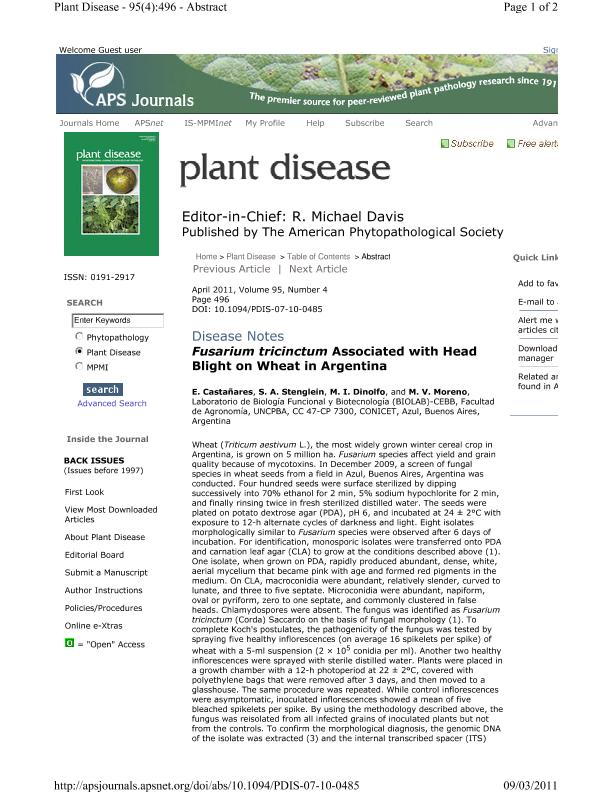Artículo
Fusarium tricinctum associated with head blight on wheat in Argentina
Fecha de publicación:
04/2011
Editorial:
American Phytopathological Society
Revista:
Plant Disease
ISSN:
0191-2917
e-ISSN:
1943-7692
Idioma:
Inglés
Tipo de recurso:
Artículo publicado
Clasificación temática:
Resumen
Wheat (Triticum aestivum L.), the most widely grown winter cereal crop in Argentina, is grown on 5 million ha. Fusarium species affect yield and grain quality because of mycotoxins. In December 2009, a screen of fungal species in wheat seeds from a field in Azul, Buenos Aires, Argentina was conducted. Four hundred seeds were surface sterilized by dipping successively into 70% ethanol for 2 min, 5% sodium hypochlorite for 2 min, and finally rinsing twice in fresh sterilized distilled water. The seeds were plated on potato dextrose agar (PDA), pH 6, and incubated at 24 ± 2°C with exposure to 12-h alternate cycles of darkness and light. Eight isolates morphologically similar to Fusarium species were observed after 6 days of incubation. For identification, monosporic isolates were transferred onto PDA and carnation leaf agar (CLA) to grow at the conditions described above (1). One isolate, when grown on PDA, rapidly produced abundant, dense, white, aerial mycelium that became pink with age and formed red pigments in the medium. On CLA, macroconidia were abundant, relatively slender, curved to lunate, and three to five septate. Microconidia were abundant, napiform, oval or pyriform, zero to one septate, and commonly clustered in false heads. Chlamydospores were absent. The fungus was identified as Fusarium tricinctum (Corda) Saccardo on the basis of fungal morphology (1). To complete Koch's postulates, the pathogenicity of the fungus was tested by spraying five healthy inflorescences (on average 16 spikelets per spike) of wheat with a 5-ml suspension (2 × 105 conidia per ml). Another two healthy inflorescences were sprayed with sterile distilled water. Plants were placed in a growth chamber with a 12-h photoperiod at 22 ± 2°C, covered with polyethylene bags that were removed after 3 days, and then moved to a glasshouse. The same procedure was repeated. While control inflorescences were asymptomatic, inoculated inflorescences showed a mean of five bleached spikelets per spike. By using the methodology described above, the fungus was reisolated from all infected grains of inoculated plants but not from the controls. To confirm the morphological diagnosis, the genomic DNA of the isolate was extracted (3) and the internal transcribed spacer (ITS) and the translation elongation factor (TEF) regions were PCR-amplified using primer pairs ITS3/ITS4 (4) and EF-1/EF-2 (2), respectively. The sequences were compared with those in GenBank. The ITS sequence (Accession No. HM635739) showed 100% similarity with several F. tricinctum sequences (e.g., Accession Nos. HM068317, FN598932, and EF589873) but also with other Fusarium species such as F. acuminatum. The TEF sequence (Accession No. HQ214681) showed 99 to 100% similarity with Accession Nos. HM068307, EU744838, and EU744837 of F. tricinctum. To our knowledge, this is the first report of F. tricinctum on wheat in Argentina. This species is known to produce fusarin C, enniatins, and moniliformin toxins. Since F. tricinctum can infect different cereal grains, a large-scale survey of cereals from fields throughout Argentina is in progress. References: (1) J. F. Leslie and B. A. Summerell. The Fusarium Laboratory Manual. Blackwell Publishing, Oxford, UK. 2006. (2) K. O'Donell et al. Proc. Nat. Acad. Sci. USA 95:2044, 1998. (3) S. A. Stenglein and P. A. Balatti. Physiol. Mol. Plant Pathol. 68:158, 2006. (4) T. J. White et al. Page 315 in: PCR Protocols: A Guide to Methods and Applications. Academic Press, San Diego, 1990.
Palabras clave:
Fusarium tricinctum
,
Cereal grains
,
Quality
Archivos asociados
Licencia
Identificadores
Colecciones
Articulos(INBIOTEC)
Articulos de INSTITUTO DE INV. EN BIODIVERSIDAD Y BIOTECNOLOGIA
Articulos de INSTITUTO DE INV. EN BIODIVERSIDAD Y BIOTECNOLOGIA
Articulos(OCA PQUE. CENTENARIO)
Articulos de OFICINA DE COORDINACION ADMINISTRATIVA PQUE. CENTENARIO
Articulos de OFICINA DE COORDINACION ADMINISTRATIVA PQUE. CENTENARIO
Citación
Castañares, Eliana; Stenglein, Sebastian Alberto; Dinolfo, María Inés; Moreno, Maria Virginia; Fusarium tricinctum associated with head blight on wheat in Argentina; American Phytopathological Society; Plant Disease; 95; 4; 4-2011; 496
Compartir
Altmétricas




